Thomas Williams, medical device innovation consultant on Kolabtree, provides 13 tips to help you reduce time to market. Scroll to the end to see the free reference cheat sheet.
Reducing the time to market in today’s medical device industry is a major challenge for both large and small companies. There are many ways to safely accelerate your product’s time to market, and none of them involve taking shortcuts. This article is intended to help Medical Device Executives and Managers who want to speed up their product development cycle using a disciplined approach aimed at eliminating risk. Often risks are unknowingly built into projects in the early stages with disastrous consequences later. Following a disciplined, process-oriented Rapid Time to Market approach more often wins the race to the market. Listed below are my top 13 tips.
Tip #1: Understand Design Controls
In the United States the process for developing new products is largely defined by the FDA’s Design Controls guideline. Take the time to understand Design Controls so that everything you do to develop your product also gets documented in the product’s Device Master Record (DMR). By documenting your product’s development to reflect the framework of Design Controls you are creating a roadmap for the evolution of the product’s design. Taking this approach although seemingly daunting in the beginning ultimately pays dividends in time and money later when seeking the FDA’s clearance to begin marketing your product.
The FDA’s Design Controls, however, should not be your only consideration for speeding your product to the market. Equally challenging is the discipline to perform the upfront work needed in advance of allowing Engineering to begin design and development activities.
Tip #2: Emphasize upfront research and planning
Sometimes referred to as a Market Opportunity Assessment this early research and planning is all too often overlooked in the rush to begin building out your DMR. The extra time you spend doing the upfront work to focus the scope of your project will serve to prevent it from straying off course and off budget later. Within the Market Opportunity Assessment process there are several tips that stand out as time savers.
Tip #3: Develop a clear Product Requirements Document
One of the most important documents in your DMR is the Product Requirements Document (PRD). This document is a compilation of several important research tasks needed to clearly define what the product is that you are planning to develop. The PRD should become the document that creates the “hand shake” between the various project team disciplines.
Tip #4: Understand the customer
Conduct market research into who the customers of this new product will be. In the world of medical devices there are usually several customers for a product to include the doctor, the nurse and ultimately the patient. Each of these customers will have different perspectives on a product. For example, the nurse may be looking for a product that will save her time while the patient would be more interested in the level of comfort the product provides. The doctor on the other hand may focus on improved clinical outcomes. Develop a persona profile for each customer that captures each of their specific requirements.
Tip #5: Identify customers’ Needs & Wants”
Toward developing a comprehensive Product Requirements Document is Tip #5 which is to identify in detail the “needs & wants” of the customers. These are the product features that your new product must deliver in order to convince your customers that you met and hopefully exceeded their expectations. The Advisory Board approach is common practice for discovering what customers are looking for in a new product. Focus Panels are also a frequently used technique for getting to this information.
The Product Requirements Document is not complete however, until the crucial step of translating these “needs & wants” into engineering design criteria is complete. For example, the customer may want the handle on a new device to be easy to grip without slipping. The engineering design translation might be to include texturing the surface of the handle or using an alternative non-slip material to provide a better grip. One by one each of the “needs & wants” is matched to its design criteria until a comprehensive product design emerges first on paper.
Tip #6: Arrive at a regulatory consensus
In the United States having an early consensus between the Food and Drug Administration (FDA) and your Regulatory Affairs Department will allow you to make better time to market. For example, if you can justify a “letter to file” approach to getting your product cleared by the FDA you will save a great deal of time versus having to take the 510k approach. In turn if you can avoid the FDA’s Pre-Market Approval (PMA) pathway by taking the 501k approach your time to market will improve even more drastically.
Also read: 13 Mistakes to Avoid in a 510(k) Submission for Quick FDA Clearance
Tip #7: Know your target market geography
Knowing in advance what regulatory requirements the product must meet in order to win approval from the various governing bodies around the world other than the FDA is Tip #10. Knowing in advance what countries your product is intended to be sold in will save you an extraordinary amount of time associated with going back over already completed development tasks just to meet unique approval requirements from other geographies such as the European Union’s MDR/EMA, Japan’s PMDA, and China’s NMPA.
Also read: How to get a CE mark for your medical device
Tip #8: Understand the Purchasing Decision
Key to your product’s success will be understanding who and how the purchasing decision is made. In large healthcare organizations the purchasing decision routinely extends beyond just the doctor, nurse, and patient. For example, new product purchasing decisions are often required to be approved by a Clinical Review Board consisting of multiple disciplines including Finance, Purchasing, Infection Control, Quality Controletc.
Ultimately however, the purchasing decision often hinges on an especially critical factor: REIMBURSEMENT. In today’s Managed Care healthcare systems where managing the rising cost of healthcare often takes center stage,your product’s success in the United States hinges on the Centers for Medicare and Medicaid (CMS). Obtaining the necessary HCPCS code for your product from CMS allows insurance providers throughout the marketplace to be properly reimbursed for the use of your product. Without reimbursement the rate at which your new product will be accepted into the marketplace will be greatly reduced until you receive CMS approval.
Tip #9: Conduct an intellectual property investigation
In addition to the Product Requirements Document there are other critical considerations that need to be addressed early in the planning stages. Tip #7 is to perform the necessary due diligence of conducting an intellectual property investigation. Nothing will slow your time to market more than the late realization that your product design infringes on existing patents.
Now is also the time to determine if your new product will contain any unique and patentable intellectual property of its own. Often the earlier and broader you make any new patent application the better protected your design will be.
Tip #10: Carefully plan time, money and resource
Your product proposal will likely not be the only project seeking approval from your company’s Management. Be prepared to demonstrate the time, money and resources needed to get your product to the market along with a projected return on investment (ROI) which ultimately drives many management decisions to proceed.
Tip #11: Use a cross-functional team approach
The 11th Tip for preventing your product development project from coming to a sudden stop is to recognize early in the project that you cannot do it alone. Getting a new medical device to the market in today’s highly regulated environment requires companies to recognize that a Cross-Functional Team approach is vital to the timely execution of a project. Too often companies will skimp on the assignment of people from important functional areas.
Perhaps the most common mistake is to neglect having a Manufacturing representative on the team. There is nothing worse than the project team thinking they have a “frozen design” only to find out that Manufacturing cannot make the product!
This is also true for other forgotten functional areas that should have a “place at the table.” For example, new products that require unique materials or components should include people from the Quality Control and Purchasing groups in order to meet production demand. Often when these other functional areas are consulted with late in a project it invariably leads to delays in time to market.
Managing a Cross-Functional Team, often across geographies and time zones, presents challenges for projects. Recognizing the need to coordinate activities of the various team members is important to maintaining continuity of tasks.
Building and managing a Timeline that includes the activities of each of the functional areas creates a group awareness for where in the process a project is at any one time. Maintaining a project timeline also serves to keep the Management team informed thus providing them with opportunities to intervene if needed by reallocating resources in order to save time.
Tip #12: Get expert help when you need it
Not all companies especially smaller entrepreneurial ones have all the necessary expertise in-house to navigate all aspects of developing and launching a new product into the market. Even large companies that seem to be vertically integrated with all the functions needed can sometimes lack specific experience in new areas. This is where knowing when you need help can make the difference between getting your product to the market on time or being beat to the market by your competition.
In today’s rapidly changing work environment a company’s full-time W2 workforce can be easily supplemented with outside resources through contract employees and freelancers, The expanding gig economy presents opportunities for companies large and small to benefit not only with faster times to market, but also the ability to lower development costs.
For example, expert regulatory affairs freelancers with years of specific experience working with your local branch of the FDA can help greatly with just one favorable decision. Technical writers practiced in the art of writing clear and concise Instructions for Use is another hard to find expertise that can eliminate user errors. Whatever the need it is sometimes faster to seek the help from outside experts versus making novice mistakes associated with doing a job yourself.
To conclude, the key to getting your product to the market as fast as possible should be clear. Doing as much of the upfront research and planning in advance of the physical designing, testing, validating, etc., will result in a more rapid time to market. It may seem counter intuitive but a rapid time to market strategy is essentially one that attempts to eliminate the roadblocks, setbacks, and mistakes upfront. Over the years successful medical device companies learn these truths often the hard way, and it is the exceptional ones that learn from these experiences by incorporating them back into a Rapid Time to Market process.
Tip #13: Avoid dismantling successful Project Teams
Smaller medical device companies such as start-up companies typically do not have this kind of historical perspective. They must rely on the expertise and experience of their teams. So, a final piece of advice for accelerating your new products to the market is to avoid dismantling successful Project Teams too soon. Allowing successful Project Teams to remain intact to build off earlier successes will allow them to gain powerful insight into the development process, and to build speed in time to market.
In today’s world however, keeping your successful teams together for more than 2 or 3 years is difficult so even small entrepreneurial companies need to devise ways to preserve the institutional learnings from pervious projects. Therefore, the sooner you begin to capture and document your Best Practices the sooner your organization will build up a knowledge base of success that does not reside in any one individual’s head.
Finally, Management can now proactively provide guidance based on experience to help groom their young project teams long after their best performing teams have dissolved. Reporting to Management on a project’s progress becomes more than just a review of the timelines. Now there is an institutional memory that Management can apply to create a more instructional exchange with their teams. Eliminating just one mistake in a project can alter its entire course. Replicating just one prior success can further speed your new product to the market!
This article has been written by Thomas Williams, a freelance medical device expert on Kolabtree. Contact him directly here or see more profiles like his.
Reduce Medical Device Time to Market: Free Reference Cheat Sheet

Ready to reduce your medical device time to market? Get help from trusted medical device consultants and freelance regulatory writers on Kolabtree. POST YOUR PROJECT NOW







